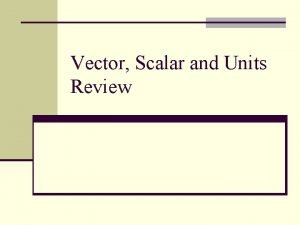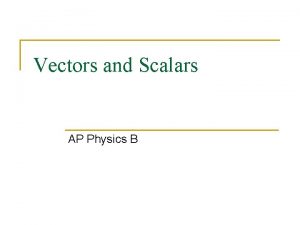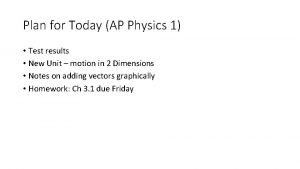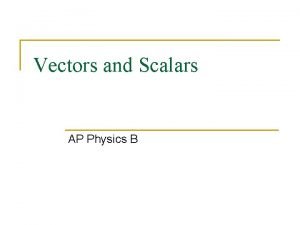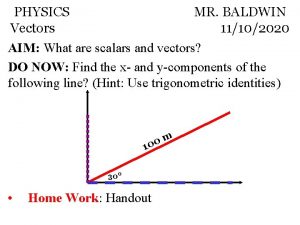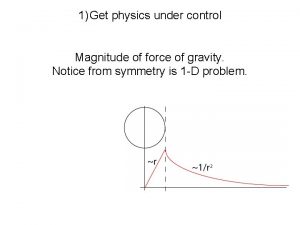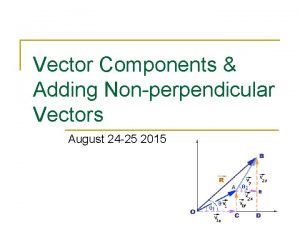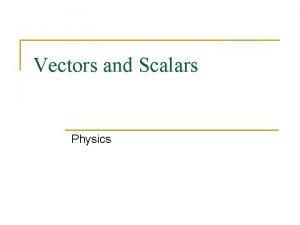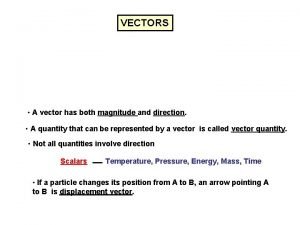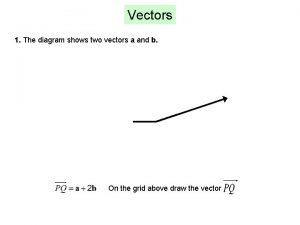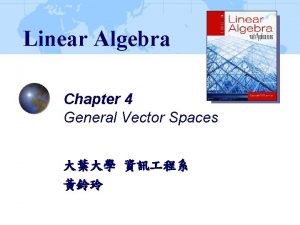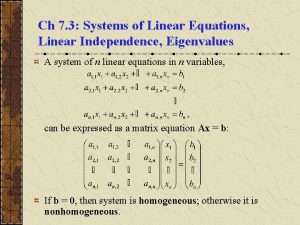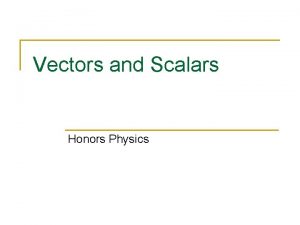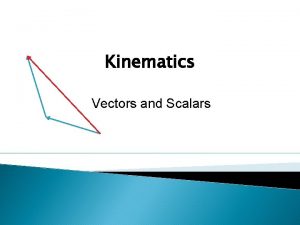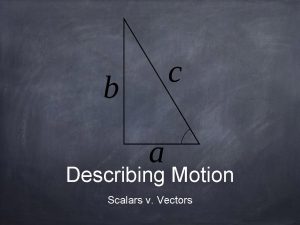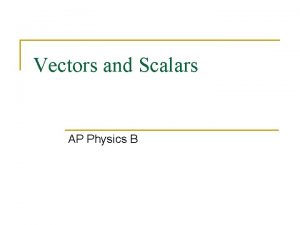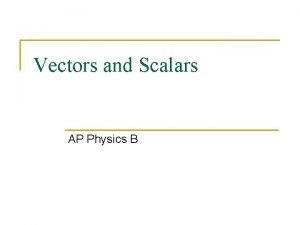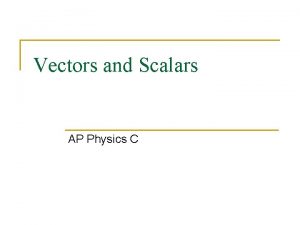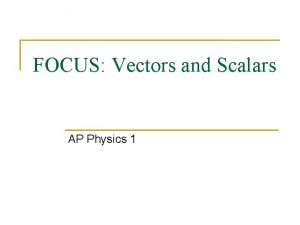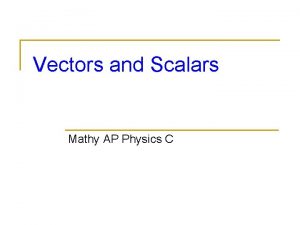Vectors and Scalars Physics Scalar A SCALAR is




























- Slides: 28

Vectors and Scalars Physics

Scalar A SCALAR is ANY quantity in physics that has MAGNITUDE, but NOT a direction associated with it. Magnitude – A numerical value with units. Scalar Example Magnitude Speed 20 m/s Distance 10 m Age 15 years Heat 1000 calories

Vector A VECTOR is ANY quantity in physics that has BOTH MAGNITUDE and DIRECTION. Vector Velocity Magnitude & Direction 20 m/s, N Acceleration 10 m/s/s, E Force 5 N, West Vectors are typically illustrated by drawing an ARROW above the symbol. The arrow is used to convey direction and magnitude.

Applications of Vectors VECTOR ADDITION – If 2 similar vectors point in the SAME direction, add them. n Example: A man walks 54. 5 meters east, then another 30 meters east. Calculate his displacement relative to where he started? 54. 5 m, E + 84. 5 m, E 30 m, E Notice that the SIZE of the arrow conveys MAGNITUDE and the way it was drawn conveys DIRECTION.

Applications of Vectors VECTOR SUBTRACTION - If 2 vectors are going in opposite directions, you SUBTRACT. n Example: A man walks 54. 5 meters east, then 30 meters west. Calculate his displacement relative to where he started? 54. 5 m, E 30 m, W 24. 5 m, E -

Non-Collinear Vectors When 2 vectors are perpendicular, you must use the Pythagorean theorem. A man walks 95 km, East then 55 km, north. Calculate his RESULTANT DISPLACEMENT. The hypotenuse in Physics Finish is called the RESULTANT. 55 km, N Horizontal Component Vertical Component 95 km, E Start The LEGS of the triangle are called the COMPONENTS

BUT……what about the direction? In the previous example, DISPLACEMENT was asked for and since it is a VECTOR we should include a DIRECTION on our final answer. N W of N E of N N of E N of W N of E E W NOTE: When drawing a right triangle that conveys some type of motion, you MUST draw your components HEAD TO TOE. S of W S of E W of S E of S S

BUT…. . what about the VALUE of the angle? ? ? Just putting North of East on the answer is NOT specific enough for the direction. We MUST find the VALUE of the angle. 109. 8 km To find the value of the angle we use a Trig function called TANGENT. 55 km, N q N of E 95 km, E So the COMPLETE final answer is : 109. 8 km, 30 degrees North of East

What if you are missing a Suppose a person walked 65 m, 25 degrees East of North. What component? were his horizontal and vertical components? H. C. = ? V. C = ? 25 65 m The goal: ALWAYS MAKE A RIGHT TRIANGLE! To solve for components, we often use the trig functions since and cosine.

Example A bear, searching for food wanders 35 meters east then 20 meters north. Frustrated, he wanders another 12 meters west then 6 meters south. Calculate the bear's displacement. - 12 m, W - = 6 m, S = 23 m, E 14 m, N 20 m, N 35 m, E 14 m, N R q 23 m, E The Final Answer: 26. 93 m, 31. 3 degrees NORTH or EAST

Example A boat moves with a velocity of 15 m/s, N in a river which flows with a velocity of 8. 0 m/s, west. Calculate the boat's resultant velocity with respect to due north. 8. 0 m/s, W 15 m/s, N Rv q The Final Answer : 17 m/s, @ 28. 1 degrees West of North

Example A plane moves with a velocity of 63. 5 m/s at 32 degrees South of East. Calculate the plane's horizontal and vertical velocity components. H. C. =? 32 63. 5 m/s V. C. = ?

Identifying Direction Write the angles shown below by using references to east, south, west, north. N N W 50 o S 500 S of E 45 o E W E S 450 W of N

Vectors and Polar Coordinates Polar coordinates (R, q) are an excellent way to express vectors. Consider the vector 40 m, 500 N of E, for example. 90 o 40 m 180 o R 180 o 50 o 0 o 270 o R is the magnitude and q is the direction. q 0 o 270 o

2 D Coordinate Spaces n n All that really matters are the numbers. The abstract version of this is called a 2 D Cartesian coordinate space. Chapter 1 Notes 3 D Math Primer for Graphics & Game Dev 15


From the right triangle in Figure 3. 2 b, we find that Sin θ = y/r and that cos θ = x/r. Therefore, starting with the plane polar coordinates of any point, we can obtain the Cartesian coordinates by using the equations 2/25/2021 17

Example 2 (Cont. ): A 400 -m walk in a direction of 30 o N of E. How far is the displacement east and how far north? N Note: x is the side adjacent to angle 300 400 m y=? 30 o E ADJ = HYP x Cos 300 x=? x = R cos q x = (400 m) cos 30 o = +346 m, E The x-component is: Rx = +346 m

Example 2 (Cont. ): A 400 -m walk in a direction of 30 o N of E. How far is the displacement east and how far north? N Note: y is the side opposite to angle 300 400 m y=? 30 o E OPP = HYP x Sin 300 x=? y = R sin q y = (400 m) sin 30 o = + 200 m, N The y-component is: Ry = +200 m

Finding Resultant: (Cont. ) Finding (R, q) from given (x, y) = (+40, -30) 40 lb Rx q f R= tan f = Ry R 30 lb x 2 + y 2 -30 40 R= 40 lb 30 lb (40)2 + (30)2 = 50 lb f = -36. 9 o q = 323. 1 o

R q Ry f 40 lb R = 50 lb Rx 40 lb Rx q q 30 lb R Ry Rx 40 lb Rx f f Ry 30 lb R q 30 lb Four Quadrants: (Cont. ) R = 50 lb 40 lb Ry R 30 lb f = 36. 9 o; q = 36. 9 o; 143. 1 o; 216. 9 o; 323. 1 o

Unit vector notation (i, j, k) y j k z Consider 3 D axes (x, y, z) i x Define unit vectors, i, j, k Examples of Use: 40 m, E = 40 i 40 m, W = -40 i 30 m, N = 30 j 30 m, S = -30 j 20 m, out = 20 k 20 m, in = -20 k

Example 4: A woman walks 30 m, W; then 40 m, N. Write her displacement in i, j notation and in R, q notation. In i, j notation, we have: +40 m R f -30 m R = R xi + R y j Rx = - 30 m Ry = + 40 m R = -30 i + 40 j Displacement is 30 m west and 40 m north of the starting position.

Example 4 (Cont. ): Next we find her displacement in R, q notation. +40 m R f -30 m q = 1800 – 53. 130 q = 126. 9 o R = 50 m (R, q) = (50 m, 126. 9 o)

2/25/2021 25


Question Magnitude =47. 2 q=122 degree

Converting Polar to Rectangular n r • y θ x 28
 Vectors and scalars in physics
Vectors and scalars in physics Vector addition
Vector addition Different between scalar and vector quantity
Different between scalar and vector quantity Scalars and vectors
Scalars and vectors Lesson plan on vectors and scalars
Lesson plan on vectors and scalars Multiplying or dividing vectors by scalars results in
Multiplying or dividing vectors by scalars results in Vector vs scalar quantities
Vector vs scalar quantities Scalar product of vectors
Scalar product of vectors Extension of scalars
Extension of scalars 700 calories scalar or vector
700 calories scalar or vector Ap physics vectors test
Ap physics vectors test Ap physics vector problems
Ap physics vector problems Vector addition
Vector addition Physics vectors
Physics vectors Nonperpendicularly
Nonperpendicularly Scalar physics
Scalar physics Tell something about the multimodal text big ed mona
Tell something about the multimodal text big ed mona Modern physics vs classical physics
Modern physics vs classical physics University physics with modern physics fifteenth edition
University physics with modern physics fifteenth edition Physics ia idea
Physics ia idea Properties of vector
Properties of vector Monia
Monia The vector has both magnitude and
The vector has both magnitude and The diagram shows
The diagram shows 2d motion equations
2d motion equations Linear algebra chapter 4 solutions
Linear algebra chapter 4 solutions Linearly dependent and independent vectors
Linearly dependent and independent vectors Vectors and the geometry of space
Vectors and the geometry of space Linear independence of vectors
Linear independence of vectors






